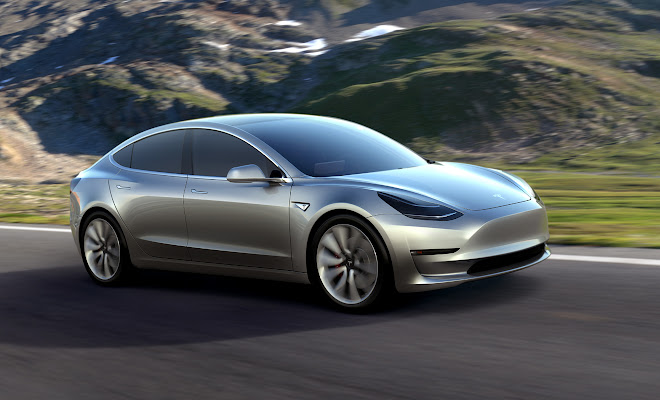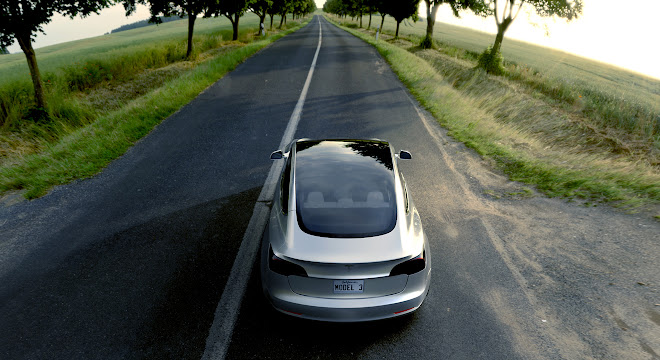by Lem Bingley 
The dust has settled following the unveiling last week of Tesla’s latest electric car, the Model 3 (or, as the company likes to write it, Model ≡). More than 276,000 people slapped down $1,000 deposits within the car’s first three days on sale, keen to reserve a vehicle that won’t arrive for at least 18 months.
So what exactly have these early enthusiasts bought into?
The basic facts are clear. The Model 3 is a pure battery powered EV capable of travelling at least 215 miles between charges, according to Tesla. It will accelerate from rest to 60mph in less than six seconds, seat five people, and is by far the cheapest Tesla yet offered for sale.
Outlay in the US will start at $35,000 (£25,000) but the UK price remains to be confirmed. Judging from current Model S pricing on either side of the Atlantic, we might expect a UK entry point of £28,000.

At the car’s unveiling, Tesla chief Elon Musk pledged that even a no-options Model 3 will represent “an amazing car”, but it seems unlikely many will be sold without any frills whatsoever. Via Twitter, Musk has clarified that the average price of a Model 3 after options is expected be around $42,000, which is likely to translate to about £34,000 in Britain.
Pictures from the unveiling show a car that’s clearly related to the more expensive Model S. What’s less obvious is that the two cars are probably made from different materials.
While the bigger car’s body and chassis are built largely from aluminium alloy, the Model 3 is likely to feature steel bodywork on top of an aluminium chassis. Tesla has been busily recruiting engineers with skills in structures that join together steel and alloy components. Non-structural panels such as the door skins and bonnet may well be alloy or composites to keep weight in check.
We don’t yet know how wide the Model 3 will be. By European standards, Tesla’s Model S saloon is quite broad in the beam even for a big car in its price bracket. At 1,963mm across with mirrors folded (or just under six and a half feet) it is wider than a Mercedes S-Class. The Model X is wider still at 2,070mm, or 6cm wider than the very chunky Volvo XC90. The Model 3 will surely be narrower – perhaps closer to the benchmark offered by a BMW 5-Series, which is more than 10cm narrower than a Model S. A slimmer Model 3 would be most welcome on narrow British highstreets, among cramped supermarket car parks and when squeezing through unforgiving width restrictors.

Another notable feature of the pre-production cars revealed last week was a fully glazed roof. Musk cited the glass as key in providing generous rear headroom (presumably due to the lack of a padded headlining).
The glazing above the rear passengers sweeps straight down to meet the bootlid in one unbroken pane – making it very clear that the Model 3 is not a hatchback like the Model S. Or at least it’s not one in its present pre-production guise. The bootlid is extremely short, and shots of the luggage bay from the launch event reveal the kind of letterbox slot normally provided by a cabriolet rather than a practical family car.
Musk has asserted that the Model 3 will be able to swallow a 7-foot surfboard, or a bicycle, so at least it’s clear that the rear seats ought to fold flat.
The glass roof might scupper the prospect of adding a roofbox for a family getaway, though it’s worth remembering that there’s no engine under the bonnet. The Model 3 will offer a capacious “frunk” up front, just like the S and X.
The video playing behind Musk at the launch event showed a 4x4 dual-motor chassis, but in subsequent tweets the Tesla CEO has confirmed that the entry level Model 3 will be rear-wheel drive, with the front motor an extra cost option.

Musk added that even the standard car should provide “great traction on ice” due to the way that an electric motor’s output can be adjusted in an instant if a tyre starts to slip, to make the best of available grip. Directly modulating the motor’s torque is a much smarter approach than today’s typical traction control system, which uses the comparatively clumsy action of applying an individual brake to rein in a spinning wheel.
Musk isn’t the slickest public speaker but he probably still chose his words carefully at the launch. Autopilot capabilities will be fitted as standard to the Model 3, he confirmed, though it seems that only safety related features will be enabled without upgrades. The same likely goes for Supercharger compatibility. Quick charging capability will be built into every Model 3, but it’s not yet 100% clear whether buyers might be asked for a one-off fee to unlock the feature.
Restricted Supercharger access might be a difficult sell, given that Tesla’s rapidly growing network of free-to-use charging stations has become a key selling point and a strong brand differentiator. The service has yet to be copied by any rival. BMW’s offer of cheap access to rental cars for i3 owners needing to take a longer trip is a pale shadow in terms of convenience.

From a design standpoint, the Model 3 has been very neatly put together, with large wheels and balanced proportions. Short overhangs front and rear, a front wheelarch positioned well forward of the doors and a near horizontal shoulder line all help to give the car a powerful, upmarket appearance. Frameless door glazing provides a four-door coupé feel.
The styling of the car’s nose, however, is already proving divisive. Tesla has abandoned the mock grille of the S and even the trim moustache of the Model X in favour of a blank snout that makes the car look like a duckbilled platypus.
Production models may well wind up looking quite different. The Model X’s grille changed substantially between its initial unveiling and production reality, so a spot of plastic surgery could be on the cards for the Model 3 too.
Inside, the Model 3 offers a cockpit stripped to the bare minimum, with all controls either on column stalks or drawn on a landscape format 15-inch touchscreen. There are no instruments ahead of the steering wheel, with speed presented in the top corner of the central screen. It seems likely that Tesla will offer a head-up display to project information directly onto the windscreen ahead of the driver, given that HUDs are now quite commonly offered by premium car manufacturers including BMW and Mercedes.
One interpretation of the minimalist interior is that Tesla is clearing the decks for a move to more autonomous driving, with increasing reliance on Autopilot capabilities. Another perhaps equally likely explanation is that the interior simply isn’t finished yet.

Tesla Model 3: what have we learned so far?
5 April 2016
Read more about: electric cars Tesla



